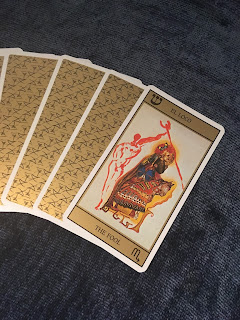Binarism in Tarot
Binaries structure the very society we live in and the cultures formed around them, which means cultural artifacts like tarot decks replicate these binaries as universal truths. But binarism is anything but universal.
Tarot esentializes humanity into basic archetypes built on binaries for the same reason that stories do: so its meaning is accessible to everyone. But in most cases, “everyone” doesn’t actually include everyone.
Traditional decks exclusively depict white, able-bodied, cisgender figures and and heterosexual couples using Western symbolism and allusions to Christianity or Judaism. As you can see, the concepts, symbols, and identities represented therein only apply to a select range of people.
Binaries are not just an antiquated, reductive framework for explaining the world--they’re foundational to oppressive systems like white, cis-hetero-patriarchy and imperialism. To learn more about the social construction of identities like gender, sexuality, and race into binaries, read this for a quick primer.
In this post, I discuss the presence of binaries in the traditional tarot and how they not only exclude marginalized groups, but limit the cards’ meanings for everyone.
Examples of Binarism in Tarot
Feminine vs Masculine Cards
 |
| The Emperor from the Dali Tarot |
 |
| The Empress from the Dali Tarot |
At their core, traditional decks function on the duality of femininity and masculinity. You can see this clearly divided into the Kings and Queens of the minor arcana, or the gendered archetypes of the major arcana.
For example, you have The Emperor and his counterpart, The Empress, whose meanings rely on heavy male and female coding. While both represent power, the cards play on sexist binaries like reason vs emotion, tradition vs creativity, father vs mother, and masculinity vs femininity.
These binaries could exist simultaneously in one person, and any of these concepts could apply to someone regardless of gender. The archetypes here are universal, but the gender binarism isn’t.
Similarly, The Hierophant and The High Priestess represent the divine male and female energies, as if their concepts of spirituality and self-knowledge require genders. Again, the “male” card possesses more traditional authority, whereas the “female” card rules over emotion.
While I feel the “female” cards can be empowering even within this sexist dichotomy, I don’t see the need to gender these concepts in modern-day tarot.
As a non-binary person, I find the compulsion to gender everything slightly absurd. Many of the gendered cards could probably be combined and still retain their core meanings for me.
Heterosexual Romance Cards
 |
| The Lovers from the Dali Tarot |
If you’re a queer taromancer like myself, you probably have some reservations about The Lovers card. In most decks, the “universal” symbol for love is a cisgender heterosexual couple. This doesn’t accurately represent people who experience same-gender or no-gender attraction, and portrays a very monogamous image for a supposedly "universal" relationship.
The Lovers card isn't just about romance; it has sexual connotations as well. For people on the ace spectrum, this could pose as either a useless card or a flexible one. For example, asexual people may see it as only a romance card, whereas aromantic people may see it only as a sexual card. However, it may not hold much meaning for aro-ace folks.
On one hand, I like that "lovers" can mean different things to different people. Everyone has different desires at different times and can interpret the card differently depending on their needs and experiences. But on the other, desire only appears as love and/or sex with one person when there are so many different types of attraction and relationships. There are no specific family or friends cards to supplement The Lovers, which I think indicates our culture's obsession with sexual-romantic relationships over other forms of love and commitment.
I think binaries of any kind should generally be avoided in favor of more nebulous systems of meaning. As writers and taromancers, seek ways of deconstructing binaries in your craft, and you will find myriads of meanings and possibilities at your fingertips.


Comments
Post a Comment